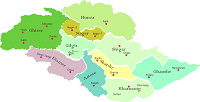The case of Gilgit-Baltistan is a clear manifestation of the failure of the political imagination of Pakistan’s ruling class
Just seven months before his death, the iconic fiction writer of Urdu literature, Saadat Hasan Manto wrote a short story titled Gilgit Khan on June 4, 1954. It is a story of Hamza Khan who comes to a city from Gilgit to work in a restaurant. There he adopts a puppy as his friend. The story ends with Hamza throwing himself on a railway track to save his dog. This story provides an interesting insight into what Manto imagined about Gilgit. In addition, it offers broader cues for exploring the role of imagination in the formation of identity and processes of unimagining identity.
In Pakistan, imagination is normally explored from a literary perspective. Rarely has it been investigated as an important political category. Benedict Anderson in his path-breaking book, Imagined Communities rejects the traditional view of nations as objective entities and claims that nations all over the world have been imagined into existence.
According to Anderson’s thesis, it is not necessary for all members of a nation to know one another but they have a clear image of their fellow citizens through imagination. In fact, most of the members of a community remain oblivious to one another.
The nation-state employs an array of institutions, practices, signs, symbols, literature, and ideals to imagine diverse people into being a nation. Gilgit-Baltistan is a part of Pakistan that has been unimagined through various administrative, institutional and ideological means. The purpose is to obliterate the human dimension from the practices and processes of representation of the region and turn it into a zone of non-being and thus keep it as an aesthetic object in the nation-building project. The aestheticization of region has had an anesthetic effect on the political question of Gilgit-Baltistan and resulted in the political alienation of its populace.
In the state of political anesthesia and historical amnesia, imagination has a crucial role. This can be well illustrated through examples from the domains of literature, history, education, representational practices, and archeology. Manto’s story, Gilgit Khan depicts Gilgit as a place that does appear to be a part of Pakistan. Indeed, while describing the central character, Hamza Khan alias Gilgit Khan, Manto describes Gilgit as the state, not the province, where Hamza lived for some time. Even the physiognomy does not suit the stereotypical face associated with the person from Gilgit.
Manto wrote the story about Gilgit Khan at a time when Gilgit was not part of the nation-building narrative. From a close reading of the story, it seems that even Manto was not very clear about Gilgit as a region distinct from other parts of Pakistan. In the story, Gilgit serves as a remote geographical space to provide a context for his character. Unlike the urbane, skilled and well-articulated city dwellers, the protagonist looks uncivilised, uncouth, untrained and inarticulate. However, he gradually learns civilised ways of working and behaving. It depicts the typical practices of representation in popular literary and academic discourse of reducing a place into a non-existent space.
Since Manto appears to be lacking the knowledge of human and cultural dimensions of Gilgit he fills that void through a leap of imagination by making the person from Gilgit to speak Urdu in a typical Pashto accent. The first time we meet Gilgit Khan speaking in the story is when he requests the owner of the restaurant for a job.
Khan says, “Kho um mulazimat chata hay…. Amaaray bhai nay likha hay, tum acha or naik admi hay…. Kho um acha or naik…. Tum kitna paisa dayga”. Reassuring the potential employer about his dedication to work Khan says, “Khan Badhisha… um tum ko kabhi tang nahi karayga, jo kahay ga manay ga”. Thus, by showing his facial feature as alien to the archetypal features of people from Gilgit, and putting alien accent into the mouth of his character, Manto constructs a character presumably from Gilgit who is not rooted and representative of the real place. However, this does not mean that Manto is displaying a weakness in his conception about Gilgit. Actually, it is emblematic of how a common Pakistani imagines the region of Gilgit-Baltistan. Until relatively recently, a majority in Pakistan deemed the people of Gilgit-Baltistan as culturally, racially and linguistically Pashtuns.
The poverty of imagination precedes political alienation. The reduction of Gilgit-Baltistan into a zone of non-being is done by robbing local populace of imagination. Manto’s story illustrates the prevailing amnesia that permeates in the general public as well as the ruling class. This is done by excluding the region of Gilgit-Baltistan from educational, historical, cultural and political representations.
Even today a majority of people in Pakistan are unaware of a different historical context of the region. For instance, in addition to commemorating the Independence Day of Pakistan on August 14 every year, the people of the region also celebrate November 1 as the Independence Day of Gilgit-Baltistan. It was on November 1, 1947, that the people of Gilgit-Baltistan expelled Dogra rule from the region through an armed struggle and established Gilgit-Baltistan as an independent state before becoming part of Pakistan.
Since its inclusion in Pakistan, Gilgit-Baltistan has remained under the thumb of patricians of political parties ruling from the Centre. Gilgit-Baltistan’s case of non-being in the political structure of Pakistan is a clear manifestation of the failure of the political imagination of its ruling class to accommodate diverse histories in the state.
Today, the society, culture, and worldview of Gilgit-Baltistan are undergoing radical transformation under the influence of modernisation and education. Although the region is losing its old identity, it is not gaining a new one because they have nothing left to imagine. Thus, people have become an unimagined community and the place unpeopled.

Nosheen Ali, in her recently published book, Delusional States: Feeling Rule and Development in Pakistan’s Northern Frontier, claims that obliterating people from the landscape “produces double exclusion: the communities of the Northern Areas remained largely unimagined within the nationalist imagining of Pakistan and Kashmir, and simultaneously, their political dispossession is also obscured from the nation’s view.”
The collective memory of history, culture, and literature of Gilgit-Baltistan is in the form of oral accounts. Modern education is essentially a representative of the written word. Therefore, new generations are trained in skills and ideas that do not resonate with their social and cultural settings. With exposure to modern education, the youth of Gilgit-Baltistan employ exogenous metaphors to express their sensibilities. They lack the required cultural literacy and repertoire to imagine their self, history, and culture in local metaphors.
Hence, it creates a being that is internally poor and externally alienated. Internally poor means lacking cultural metaphors and vocabulary to imagine oneself. The prevalent education system in our country first deprives the person of his/her internal riches and constructs a self through externalities, which include national ideology, imagining culture, attire, ideas, history, and ideals.
Gilgit-Baltistan is represented in discursive practices of Pakistani state only as a geographical space. This empty state is filled with imagery constructed by the state. Hence, we see representation of Gilgit-Baltistan in the currency of 50 rupees denomination with a picture of K2 mountain. Similarly, official maps depict the region as geo-strategically important. But when it comes to the human dimension, the state prefers to keep the region absent from its representation. That is why the results of the 2017 Census related to Gilgit-Baltistan have not been made public yet, though the data for the rest of the country is available to the public.
Nosheen Ali calls such exclusionary modes as unseeing [sic]. She thinks that “such modes suggest that far from embodying legibility, liminal, suspended pace like Gilgit-Baltistan occupy a structural political indeterminacy that may translate into their illegibility within national discourses. Moreover, this illegibility serves to invisiblize the region, its people, and their political marginalization from the imagination of ‘Pakistan’ and ‘Kashmir’…”
Formation of imagination is a result of a complex interplay between different senses, sensibilities, sensitivities, ideals, landscapes, and ideas. The strategy for capturing the imagination does not remain confined to the mental domain only, it also tries to imbue physical landscape in ideological colours so that the visual vistas can be filled by desirable image for the eyes and messages for the mind.
In every society, various forces vie to capture the imagination of the people. In Gilgit-Baltistan, these forces are sect, state, politicians, multinationals and modern institutions. This process is well illustrated at different archeological sites in Diamer, which is home to more than 50000 petroglyphs and rock carvings. A Senator from another province superimposed his name and “contributions” on 1700-years-old petroglyphs at an archeological site at Thalpan Das in Chilas.
At the same place, comes a banned religious outfit later to write its slogan over a stupa carved on the rock. Then a multinational cellular phone company applies its imagination over the petroglyphs. Finally, someone with patriotic fervour comes to teach the old Buddhists loyalty to the country by painting a flag and superimposing the phrase ‘Dil Dil Pakistan’ on the stupa besides the Karakorum Highway (KKH).
Acts-of-vandalism images on an archeological site provide a perfect metaphor for the state of local imagination, which is under threat from exogenous forces bent upon erasing old memories through new graffiti. In this instance, the overwriting by different actors and forces on historical petroglyphs symbolises erasure of the collective history, memory, and imagination of the people of Gilgit-Baltistan. The most unfortunate aspect is that it does not leave any traces like palimpsest to recover the lost and suppressed history. Rather, it is a complete obliteration of history.
Gilgit Khan is forced to commit suicide, not by internal necessity or pathological fascination with death, but by externalities in the shape of derision by the damsels he is infatuated with and castigation by his employee. Khan sees himself as a lesser human and tries to clear his conscience by attempting to kill his dog by throwing it before the train. At the last moment, he sees more humanity in the eyes of his dog. To assert his own humanity, he pushes the dog aside and jumps before the moving train to end his life.
The existential condition of the people of Gilgit-Baltistan is not human as they cannot assert their humanity because being denizens of the zone of non-being; they lost the capacity to imagine even themselves. So, they perpetually remain in the state of unimagined community within the imagined state of Pakistan. Such a situation pushes society on a suicidal path.
The prevailing sectarianism, rampant corruption, changing values, economic inequalities and disgruntled youth in Gilgit-Baltistan are symptoms of a malaise fostered and festered by the system.
To avert the collapse of the society and system, it is imperative to change the existing political arrangements, institutional set-up, and power relations and allow people to imagine a peaceful, creative and open society by themselves. Only by imagining ourselves differently, can we take ourselves out of the prevailing morass.
This article was first published in The News on Sunday, Nov 10, 2019.
 Aziz Ali Dad is a Gilgit-based writer, columnist and a fellow of Asia Leadership Fellow Program, Tokyo, Japan. He can be reached at: azizalidad@gmail.com
Aziz Ali Dad is a Gilgit-based writer, columnist and a fellow of Asia Leadership Fellow Program, Tokyo, Japan. He can be reached at: azizalidad@gmail.com

Aziz Ali Dad is a social philosopher with a deep interest in the history of ideas. He holds an MSc in Philosophy of Social Sciences from the London School of Economics and Political Science. A prolific writer and columnist, Aziz contributes to The Friday Times, The High Asia Herald, HumSub, and Baam-e-Jahan, where he explores a broad range of topics including philosophy, culture, politics, and literature. His research has been published both nationally and internationally, reflecting his intellectual reach and depth. Aziz has also been recognized as a Crossroads Asia Fellow at the Modern Oriental Institute in Berlin, Germany, and a Fellow of the Asia Leadership Fellow Program in Japan. Email: azizalidad@gmail.com

